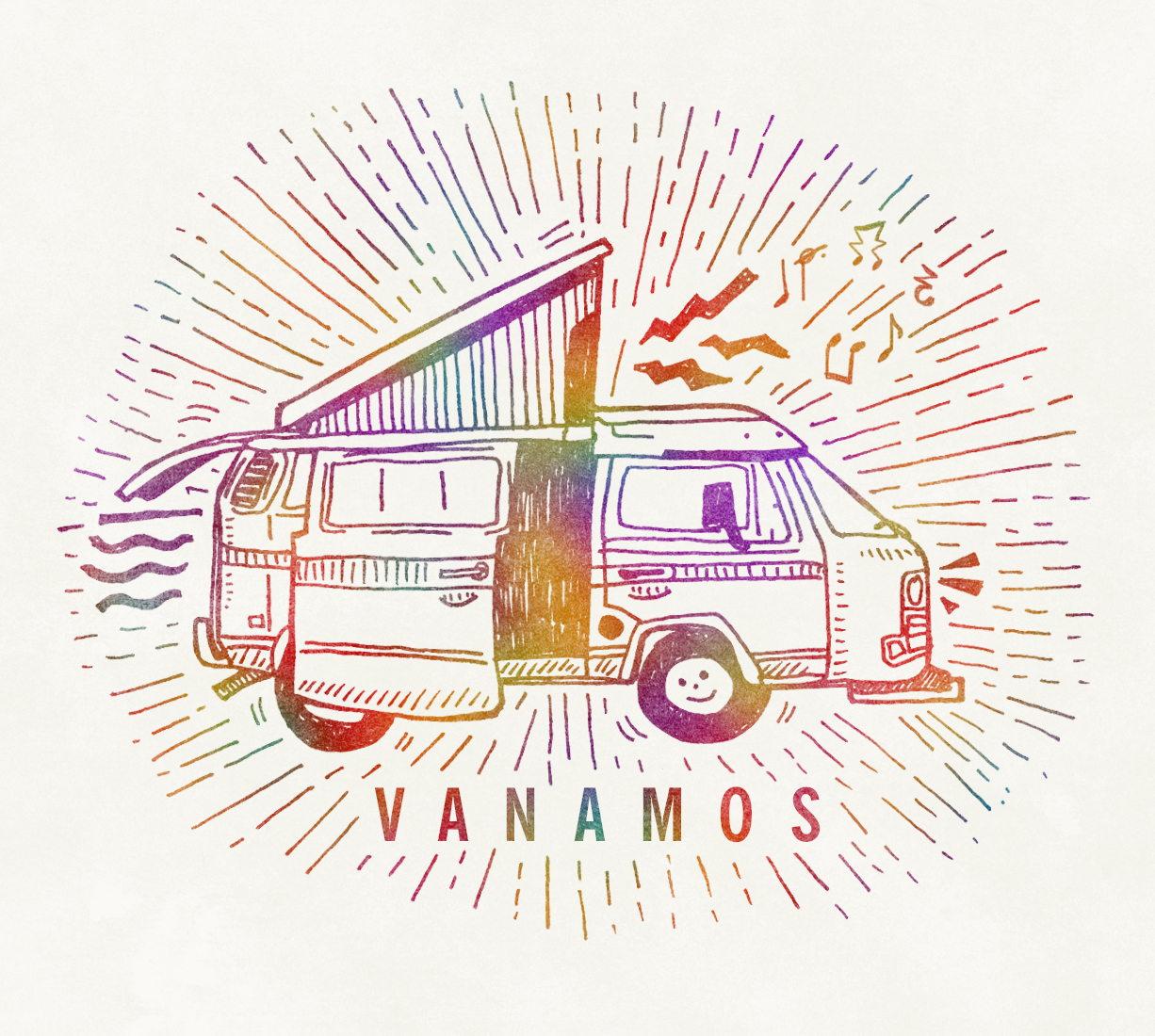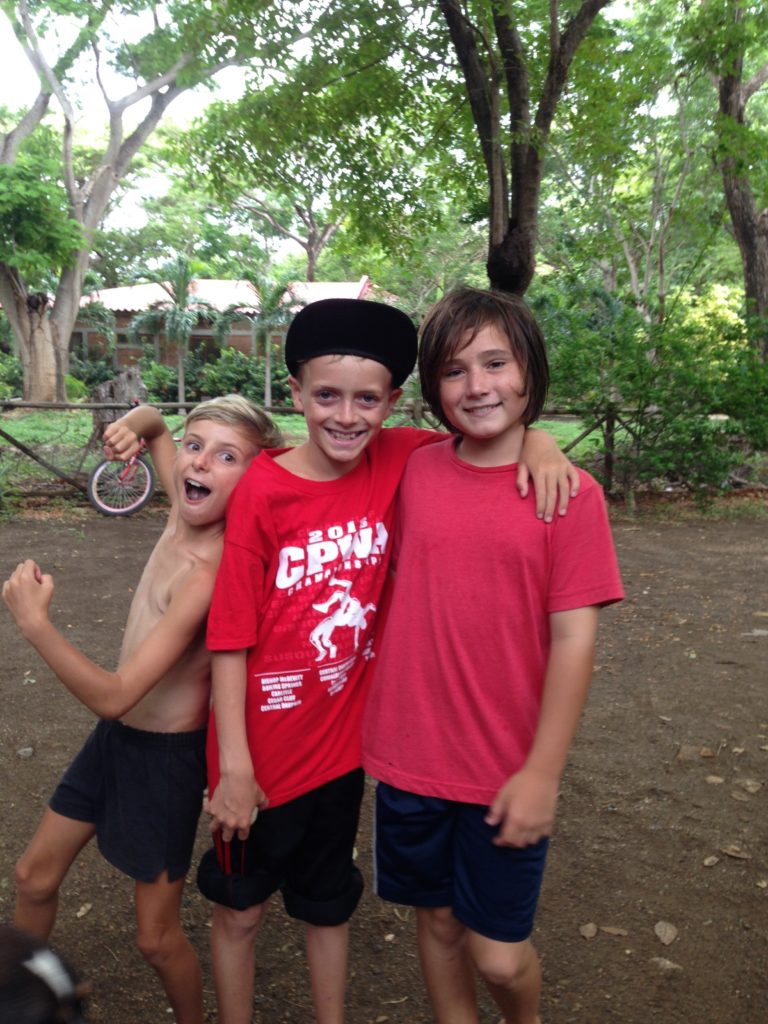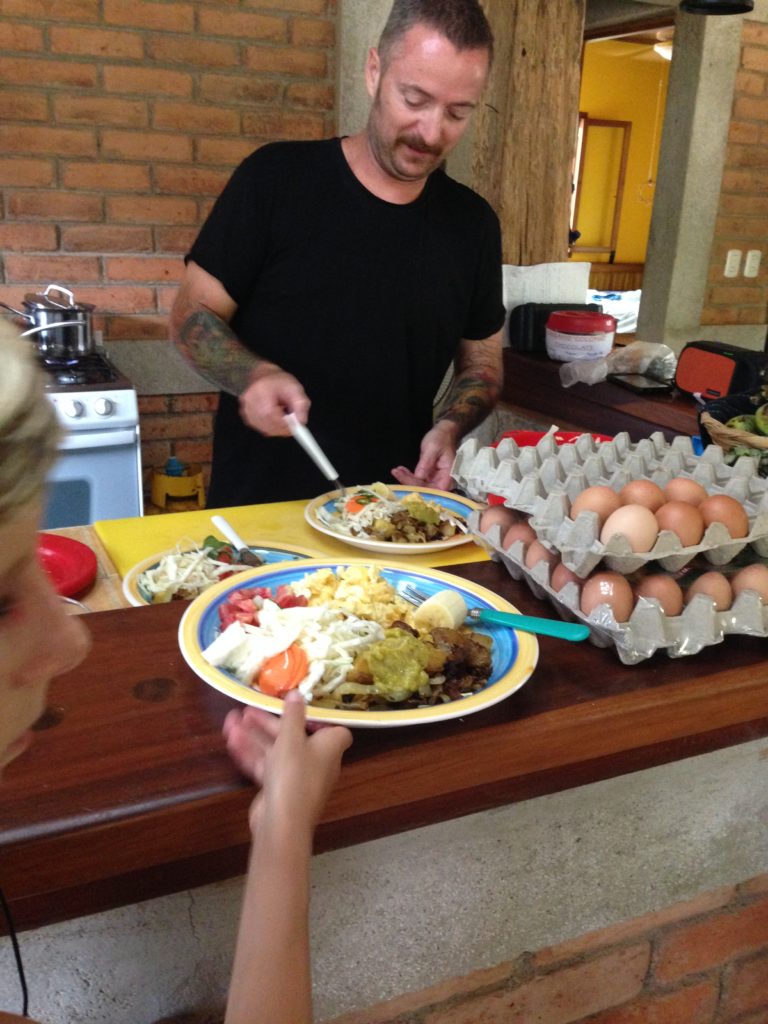Vanamos family with our gracious hosts moments prior to departure.
We finally left the comfort of Paul and Marisa’s front yard after spending 11 days going to the beach, riding bikes, going to a rodeo, eating home cooked meals, and making natural skin products. Coconut learned to make kombucha, a fermented non-alcoholic hippie drink, and got her own “scoby” to make more, and we even celebrated Paul’s birthday by taking him out to a restaurant in one of the first downpours of the rainy season.
Friends, goofy hats and poses and all.
Selling hippie products at the farmers market.
In Nicaragua, you too can be mauled by a bull.
Everyone got along easily and we could have stayed even longer with this generous, fun, and like-minded family but we’ve learned a few things by always being the last to leave the party. One of the things we’ve learned is that eventually you’ve got to leave the party.
Paul doing what he loves - getting ready to eat.
Our next stop was Granada, which was founded by someone named Cordoba in 1524 and which bills itself as the oldest city in North America. I’m not sure how to reconcile that claim with the facts that 1) it’s in Central America, not North America, and 2) the indigenous peoples all the way up to Mexico had been living in cities for centuries before the Spanish arrived. However, I think we can all agree that calling it the “first city the Spanish renamed and enslaved the occupants” is not a good slogan to attract tourists.
The view from the main square in Granada from the clock tower of the main church.
Nevertheless, Granada does have a long and interesting history. Because of its importance as a trade hub on the shores of Lake Nicaragua, it’s been sacked, looted, and burned to the ground multiple times by pirates - including by Sir Henry Morgan - one of the high-seas bandits the British Crown knighted to wreak havoc on the Spanish colonial empire.
Cannon and monument near the Parque Colon commemorating the heroes of Granada
William Walker, the American mercenary and self-proclaimed grey-eyed man of destiny, also took the opportunity to put the torch to the city in 1856 when the Nica Conservatives and Liberals united to depose him of the presidency that he had won in an election he had rigged. Walker was eventually captured and executed in Honduras.
Gun powder storage facility called La Fortaleza. It's the closest I've come to seeing a Spanish fort on this trip.
Each time it was turned to ashes, however, Granada has rebuilt, and it is now renowned for its colonial architecture, and wide, tree-lined avenues. We stayed at Hotel Antigua Estacion Granada, a beautifully restored colonial home with lush gardens in the interior courtyards. I was excited to walk the city in the relative coolness of the morning to see all the places that had been burned and rebuilt and then come back for a dip in the hotel pool before breakfast. I’m not kidding. I really was excited.
Colorful row houses in Granada
R poses in front of the small pool at our hotel in Granada. There were basil plants growing behind the lounge chairs and we cut a few leaves to have with tomatoes we got in the market.
In the afternoon, we took a horse-drawn carriage ride through the streets and climbed the bell tower of Iglesia La Merced, the second oldest church in Granada, for a view over a sea of red-tiled roofs to the lake and with Vulcan Mombacho like a bearded giant on the southern horizon.
Iglesia La Merced in Granada
J at the reins
There was more to see and do in and around Granada, but time is running short so we traveled northwest into the hilly interior of Nicaragua, landing in Somoto. This medium-sized city (pop. 15,000) would be our last overnight stop in Nicaragua before we crossed the border to Honduras and pushed on to El Salvador.
Somoto, and the villages and mountains around, have long harbored supporters of the populist government movements in Nicaragua, so have been points of interest for U.S. Marines and the C.I.A. as the U.S political machine interferes again and again in Central American politics. There are apparently several hikes in the area to places of importance for the Sandinistas, including the remains of a plane they shot down during one of its strafing runs over the area, but we didn’t do any of that.
Evidence of the revolution. In the 1980's revolutionaries roamed the hills around Somoto and their presence is still felt with murals like these.
Wesley, the golden treasure, lies at the end of this rainbow in Somoto, Nicaragua.
Instead, our plan was to visit the Grand Canyon of Somoto, so J could add to the list of things he has jumped from. Our first visit to Nicaragua in January took us past the canyon, which intrigued us, but we couldn’t stop because we were anxious to see R’s friend at Pochomil. We were happy to get another shot at it.
However, the day of the tour, J woke up feeling poorly and just as we were about to call our guide to cancel, he showed up at the hotel and told us the trip was canceled because the river was too high - it has been raining daily as the country heads into the rainy season.
Because we didn’t have plans or obligations or anything else to do, we decided to leave the country. It’s one of the nice things about being accountable to no one - you can do what you feel like doing. We could have chosen to stay too.
Rather than rappel in the canyon, J and I did some work on Wesley. The 31-year old muffler bracket has rusted through so we had to rig a wire to hold the muffler in place until we can get to a repair shop.
In fact, we might have stuck around Nicaragua another day or two if circumstances were different. In total, we spent about two months of our year trip in Nicaragua, so we obviously liked it. Leaving just like that is not the send off we would have given it. But, we know we will be returning in a few months to sign the closing papers on the piece of property that we purchased at the beach. We might be back to Nicaragua a few times after that as well. Maybe one of those times we’ll get to do the damn Somoto Canyon.
Abi joins R and I as we stand outside our Nicaraguan lawyers office after having signing a purchase agreement for a lot in the Bosques del Mar development. purchase land
Our border crossing into Honduras was like all of our border crossings except the first: unplanned and without ceremony or fanfare. We are getting pretty good at borders - R stands in line for the vehicle permit, I stand in line to get our passports stamped, Coconut and J are available to step in if I need to go over there or if R needs to come over here, or if someone needs to go to Wesley to get money to buy grilled meat on a stick from one of the vendors - and it took us less than an hour to check out of Nicaragua and into Honduras.
Unlike our previous mad dash across Honduras in January made under a big, blue sky and through parched, dusty valleys, this trip was gray and rainy. Still, we made the border with El Salvador in less than four hours, including a half-hour for lunch under a shady tree at a gas station.
Our plan for El Salvador was to go to the Pacific coast to a turtle and pelican rescue place, but we scrapped it because it was going to be dark before we got there. Instead, we ended the day in a town a dozen kilometers from the border. We’re not sure yet what we’ll do tomorrow.

















